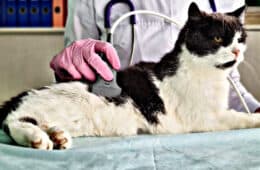Cats sometimes act strange, but what if it's more than just a quirk? Our article dives deep into a common yet mysterious ailment in our feline friends: Feline Lower Urinary Tract Disease (FLUTD).
We'll explore the symptoms, causes, and ways to prevent it possibly. This might be needed information if your cat is struggling or behaving differently.
Keep reading to find out what every cat owner should know.
What is FLUTD?
Feline Lower Urinary Tract Disease (FLUTD) is the name given to a complex of urologic medical conditions in cats, including Cystitis (inflammation of the urinary bladder), urinary stones, and urinary obstruction.
It is sometimes referred to as FUS (Feline Urologic Syndrome).

A full blockage of the urinary tract is a life-threatening condition. The cat can go into a coma and die within 24-72 hours!
Therefore, if your cat stops urinating, you should get it to a veterinarian ASAP. It is a medical emergency that can result in agonizing death.
Who's at Risk?
It is estimated that FLUTD occurs in 1 percent of all cats, affecting both males and females. Due to their narrow urethra, males are more susceptible to urinary tract blockage.
Why some cats develop FLUTD and others do not is still unknown, although there are indications that certain types of cat food may trigger the formation of crystals and stones in some cats.
A low intake of water may also be a cause of FLUTD.
After the first time a cat has FLUTD, he or she is more likely to experience it again in the future.
Symptoms of FLUTD

Symptoms of FLUTD include pain during urination, often signaled by crying during urination.
One of the first signs of FLUTD may be urination outside the litter box. Dribbles of urine can be found around the home as the cat tries to avoid the pain associated with the litter box.
Therefore, any cat that urinates outside the litter box must be checked by a vet to rule out FLUTD. Only then can the problem can be addressed as a behavioral problem.
SIGN UP FOR THECATSITE'S EMAIL UPDATES >
Other symptoms may include excessive licking of the genitals, frequent visits to the litter box with little or no result, squatting and straining during urination, and blood in the urine.
Some cats develop a form of FLUTD called Feline Idiopathic Cystitis (FIC) and suffer from recurrent flare-ups.
If you think your cat has FIC, read more here -
Feline Idiopathic Cystitis How To Improve Your Cats Life Quality
Treatment of FLUTD

As FLUTD can quickly develop into an emergency, especially in male cats, you should immediately get your cat to the vet.
The vet will treat the problem according to the specific medical condition. If there is a blockage, a catheter will likely release the obstruction.
Treatment depends on the cause of FLUTD. Your vet will perform a urinalysis to check for the presence of bacteria.
An ultrasound or x-ray may also be performed to check for bladder stones or tumors.
In case of bacterial infection, your vet will prescribe a course of antibiotics. Otherwise, changing diet and addressing stress are key features of treatment.
Prevention of FLUTD

It is hard to prevent FLUTD as no one knows what causes it. A good rule is to keep the litter box clean and always provide your cat with fresh water.
Some kinds of recurrent episodes can be avoided by following a specially prescribed diet, which controls acidity in the cat's urine.
Although these diets are expensive, following them for as long as your vet prescribes them is important. They are usually adapted to the crystals forming in the cat's urinary tract.
Many veterinarians believe a wet diet is preferable to ensure your cat's water intake is high enough and helps dilute the urine even further.
Consult with your vet on the best course of treatment and prevention that is preferable in your case.
SIGN UP FOR THECATSITE'S EMAIL UPDATES >
Comments? Leave them using the form below. Questions? Please use the cat forums for those!
Note: We may get commissions for purchases made through links on this page.



.jpg)
4 comments on “Feline Lower Urinary Tract Disease (flutd)”